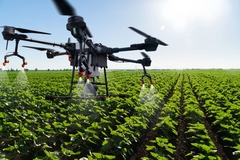Major progress is vital to hit food loss reduction targets, says FAO report
15 Oct 2019 --- A new UN Food and Agriculture Organization (FAO) report that examines how much food is lost – as well as where and why – at different stages of the food supply chain, calls for informed decisions for an effective waste reduction and offers new ways to measure progress. This will not only help to achieve progress toward the important target of reducing food loss and waste but could also contribute to a number of Sustainable Development Goals (SDGs) related to food security and environmental sustainability, the report states.
Approximately 14 percent of the world's food is lost after harvesting and before reaching the retail level. This includes loss through on-farm activities, storage and transportation, according to the State of Food and Agriculture 2019. However, the food losses vary considerably from one region to another within the same commodity groups and supply chain stages.

Highlighting the need to measure carefully losses at each stage in the food supply chain, the report says this will help to identify critical loss points across the supply chain.
The report also offers a new methodology. There are points where food losses have the highest magnitude, the greatest impact on food security, and the largest economic dimensions, as well as to identify the appropriate measures for their reduction.
The report also points to the importance of reducing food waste, which occurs at the retail and consumption level and is linked to limited shelf life and consumer behavior, such as demanding food products that meet aesthetic standards, and limited incentive to avoid food waste.
“As we strive to make progress towards reducing food loss and waste, we can only be truly effective if our efforts are informed by a solid understanding of the problem,” says FAO Director-General Qu Dongyu. He questioned, ”how we can allow food to be thrown away when more than 820 million people in the world continue to go hungry every day.'”
Targeted action
Evidence presented in the report shows a vast range in terms of loss and waste percentages within commodities, supply chain stages and regions, suggesting there is considerable potential for reduction where percentages are higher.
Losses and waste are generally higher for fruits and vegetables than for cereals and pulses at all stages in the food supply chain, except for on-farm losses and those during transportation in Eastern and South-Eastern Asia.
In lower-income countries, more fresh fruit and vegetable loss is attributed to poor infrastructure than in industrialized countries. Many lower-income countries lose significant amounts of food during storage, often due to poor storage facilities, including refrigerated warehouses.
Most high-income countries have adequate storage facilities, including refrigerated warehouses, which are available throughout the supply chain. However, losses do occur during storage, generally because of a technical breakdown, poor management of temperature, humidity or overstocking.
The report also reveals the results from several case studies conducted by FAO for identifying critical loss points. Results indicate that harvesting is the most frequently identified critical loss point for all types of food. Inadequate storage facilities and poor handling practices were also named among the main causes of on-farm storage losses. For fruits, roots and tubers, packaging and transportation also appear to be critical.
The report urges countries to step up efforts to tackle the root causes of food loss and waste at all stages and guides policy and interventions to reduce food loss and waste.
Reducing food loss and waste generally entails costs, and farmers, suppliers and consumers will only take necessary measures if their costs are outweighed by the benefits. Thus, changing incentives for various stakeholders in the supply chain will involve identifying options that either increase the net benefits or provide better information on the existing net benefits, the report states.
Even when stakeholders are aware of the benefits of reducing food loss and waste, they may face constraints that prevent them from implementing actions. For example, without financial help private actors in developing countries, especially smallholders, may not be able to bear the high upfront cost associated with implementing such actions. Improving credit access could be an option even in the absence of detailed information on losses.
The report will also help governments to analyze constraints and trade-offs for more efficient interventions. For example, they can raise awareness of the benefits of reducing food loss and waste among suppliers and consumers and influence their decision-making through various types of actions or policies.
However, the report stresses that the policy measures aimed at reducing food loss and waste should be coherent and involve effective monitoring and evaluation of interventions to assure accountability of existing actions and efforts.
Edited by Gaynor Selby













